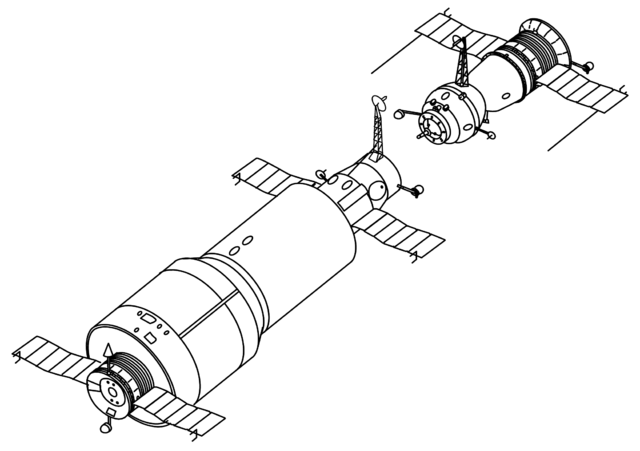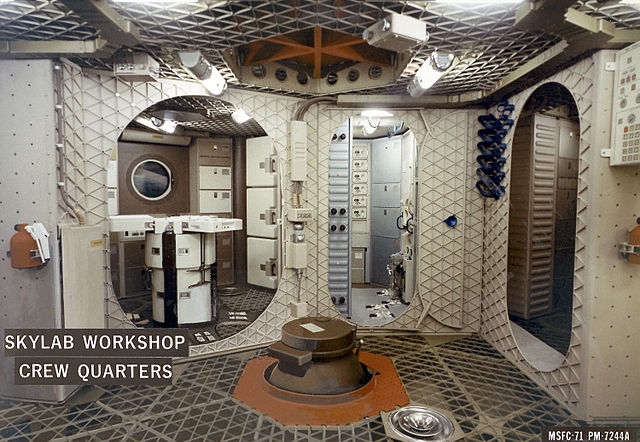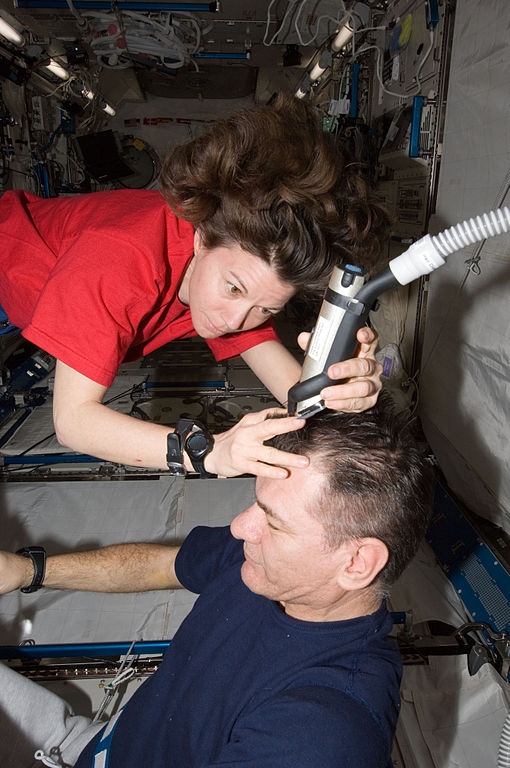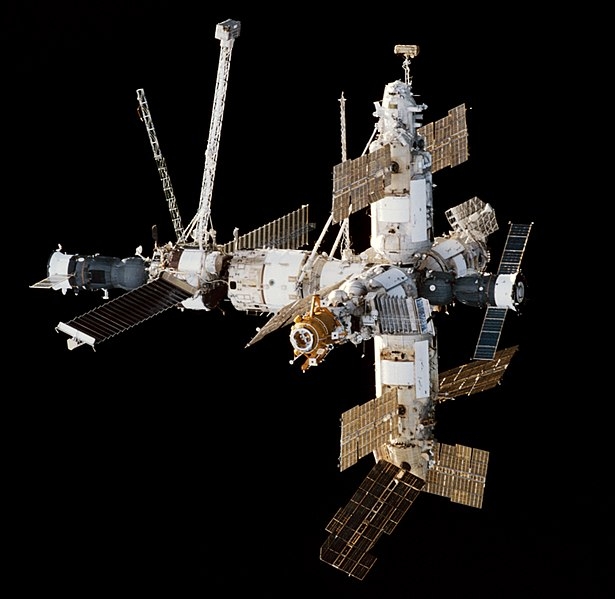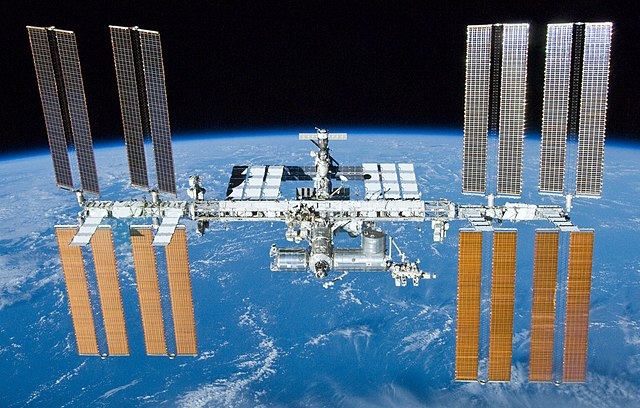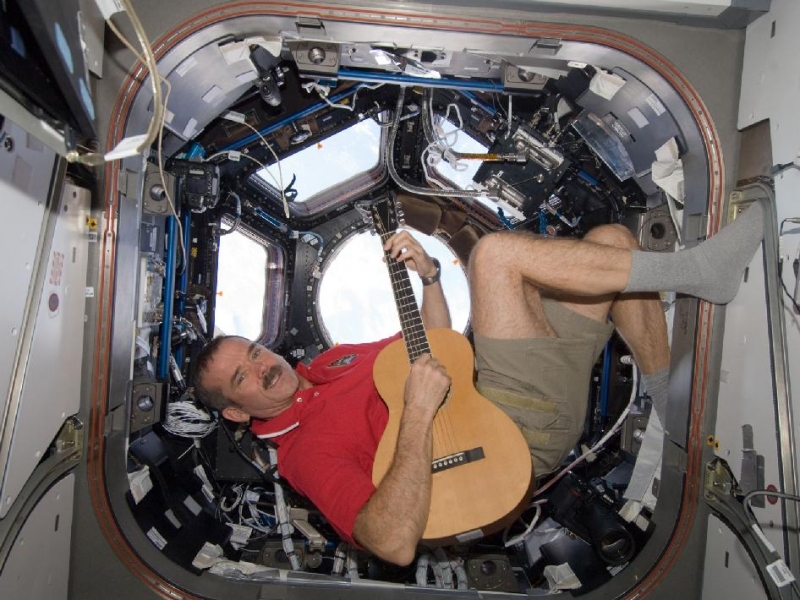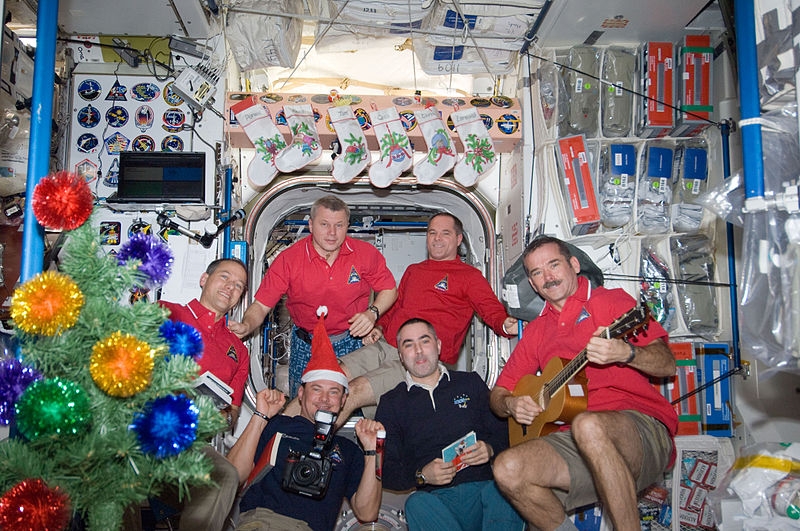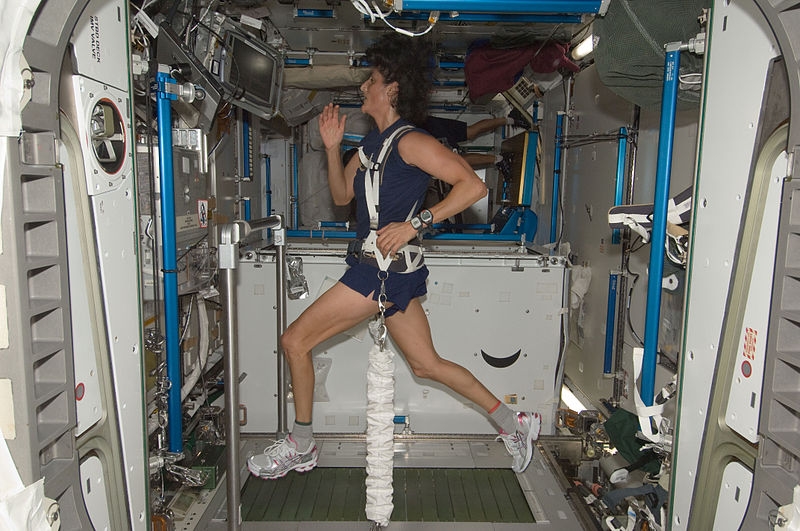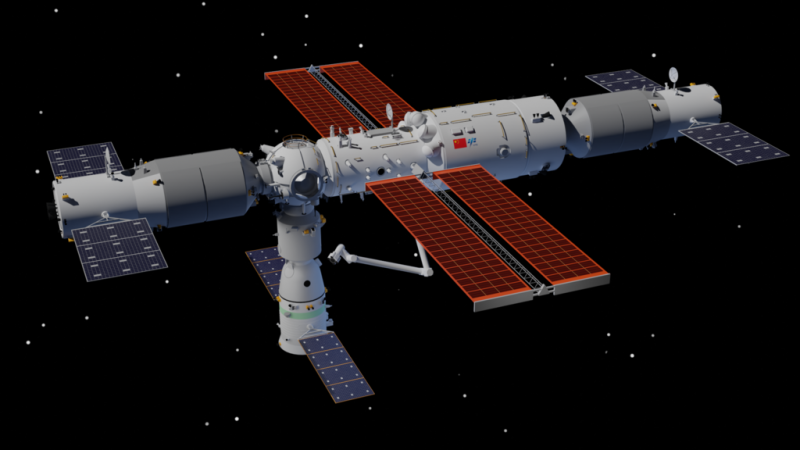Home Sweet Home In Space
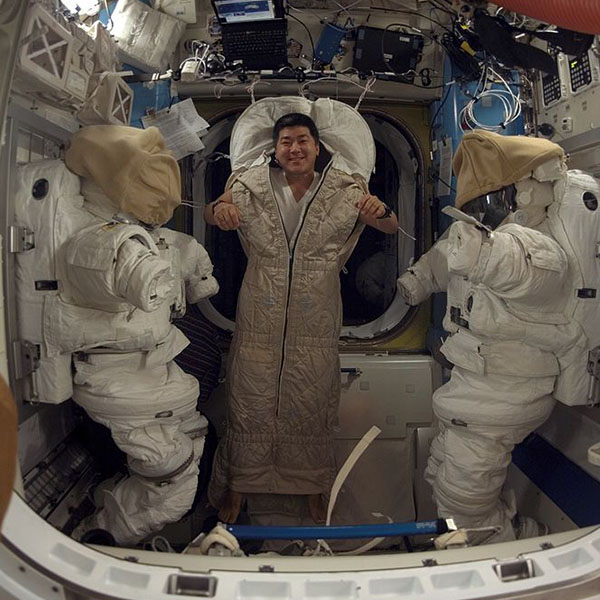
Astronaut Daniel Tani in the ISS (NASA, Wikimedia Commons).

Astronaut Daniel Tani in the ISS (NASA, Wikimedia Commons).
How does this align with my curriculum?
Learn about the history of space stations and how they help us learn about space.
The next challenge after getting humans into space was to build a home away from home for the crews. It was long felt that the ability to stay in space for an extended period of time was important. After all, research and experiments take time to complete! This is why people designed and built space stations. These structures allow scientists and engineers to test many things, such as long-duration human space missions, while actually living in space. Since people can live in space stations for months, it’s not surprising that engineers designed space stations with some familiar comforts of home.
The First Space Station
Image - Text Version
Shown is a black and white line drawing of the Soyuz spacecraft docking with the Salyut1 space station. Both the spacecraft and space station are cylindrical in shape. Both also have small solar panels come out from their sides.
Crews of three travelled to and from this space station using the Soyuz spacecraft. The nine Salyut space stations allowed the cosmonauts to make important observations about weather, land use, and astronomy.
Did You Know?
Each Salyut space station is about the size of a school bus.
Most importantly, these stations allowed researchers to study the effects of space on the human body over time. Some of these effects include the weakening of muscles and bones due to microgravity.
Second-generation Salyut space stations had visits from dozens of spacecraft and crews. They were also the first to use the Progress Delivery Spacecraft. The resupply craft brought air, water, food, clothing, bedding, mail and other supplies to the space stations.
The United States Enters the Race
Two years after the launch of Salyut 1, the United States launched its own space station. Skylab was built using a section from the Saturn V rocket. This is the same type of rocket that was used to launch the capsule for the men who landed on the Moon in 1969. With its incredible 7-metre diameter, Skylab remains the single largest ‘room’ launched into orbit to date.
Unlike the cramped space capsules, Skylab was more like a home. Skylab had a kitchen, which allowed astronauts to prepare food. Meals such as soups and stews were rehydrated using hot water. The kitchen included a fridge/freezer and a dining room table with magnetic trays and utensils. What an out-of-this-world dining experience!
Did you know?
The freeze-dried astronaut ice cream you can purchase never made it onto any space missions. It was too crumbly to eat and would have caused problems for the air filters and other equipment on board. Starting from 1973, space stations were equipped with a fridge/freezer and astronauts occasionally enjoyed regular ice cream.
Image - Text Version
Shown is a colour photograph of an interior section of the Skylab space station. From left to right is the dining area, waste management (toilet), and sleeping quarters. There are medical experiments in the foreground. The round brown object in the center of the room is the trash disposal airlock.
As you can probably imagine, using the toilet in space can be very challenging! Astronauts must first position themselves over the toilet. Then they strap themselves on, so that they do not float away!
Did you know?
Astronauts must practice using training toilets on Earth before their missions.
Once on the toilet, a lever is pushed and the solid waste gets sucked down the tube. A different tube is used for urine. Each astronaut attaches to his/her own personal urination device that looks like a small cup. As they urinate, an air current sucks the liquid through the tube and into a waste compartment. When they are done, they wipe themselves with toilet paper and clean the toilet with wet wipes. For more on space toilets, check out Space Plumber from the Canadian Space Agency.
Image - Text Version
Shown is a colour photograph of two astronauts aboard the ISS. NASA astronaut Catherine (Cady) Coleman assists European Space Agency astronaut Paolo Nespoli with a haircut in the Kibo laboratory on the International Space Station. The two Expedition 27 flight engineers used a vacuum cleaner (partially out of frame) to remove free-floating hair particles from the air.
Although Skylab was like a house, astronauts did not have bedrooms. Instead, each astronaut had a private sleeping area about the size of a small walk-in closet. It included a curtain, sleeping bag, and locker.
Mir
Unlike Salyut and Skylab, the Mir space station was launched piece-by-piece. This helped to solve the problem of launching big things into space. In this case, the Russians launch individual modules. These were interlocking units that could be assembled in space to create a larger station.
Image - Text Version
Shown is a colour photograph of the Mir Space Station viewed from Space Shuttle Endeavour. The space station looks a lot like 3 Salyut modules stuck together. Two connected end to end and one connected perpendicular to them. There are antennas and solar panels in a number of locations.
Over the years, astronauts and cosmonauts from 12 different countries visited Mir. A 1995 space shuttle mission included Canadian astronaut Chris Hadfield, who was delighted to find a guitar waiting for him on board the station.
The International Space Station
Right now, the main meeting place for astronauts from around the world is the International Space Station (ISS). It is currently home to about six people who orbit the Earth about 16 times a day. You may have even seen the ISS yourself! At night, it looks like a constant bright, white spot of light moving quickly across the sky. To find out when the ISS will be visible near you, enter your location at NASA's 'Spot the Station'.
The ISS was developed and built by five different space agencies. These are the Canadian Space Agency (CSA), the United States National Aeronautic and Space Administration (NASA), the European Space Agency (ESA), the Japan Aerospace Exploration Agency (JAXA) and the Russian Roskosmos (RKA).
Did you know?
The ISS is about the size of a football field and it is the largest object ever assembled in orbit.
Image - Text Version
Shown is a colour photograph of the International Space Station in space. The photo was taken in 2010 after docking with the shuttle Atlantis. The Earth can be seen under the ISS. The station has its main living sections in the middle and four sets of solar panels alongside like wings.
As the only place where humans can perform science in space, many of the modules are laboratories. In these labs, Earth-based scientists can take advantage of the unique microgravity environment. Experiments on combustion sit next door to ants busily constructing colonies. Airlock modules allow the astronauts to perform spacewalks and service the station.
Did you know?
Canada has provided some critical robotics to the ISS including the Canadarm2 robotic arm and Dextre, a robotic hand on Canadarm2.
Image - Text Version
Shown is a colour photograph of astronaut Chris Hadfield sitting in the cupola module of the ISS. He is in shorts and a t-shirt and is holding a guitar.
Home Sweet Space Home
Some parts of life on a space station are very different from life on Earth, and some parts are remarkably similar!
Food
To keep the astronauts happy and well fed, there is an impressive variety of food available on the ISS including fresh fruits and vegetables, hamburgers and even sushi. One thing that all visitors to the ISS have in common, no matter what their nationality, is a taste for spicy food. Why is this? It’s because many astronauts get stuffy noses when in microgravity. This dulls their sense of taste and smell.
Although eating food in space sounds like fun, astronauts must be careful to eat every bit of food. This is because crumbs and droplets can clog up the station's air filters and other equipment, which would be very dangerous!
Image - Text Version
Shown is a colour photograph ofFood for American astronauts on board of the ISS on display at the Euro Space Center in Belgium.
Food items displayed in small labelled packages include pineapple juice with a plastic straw, candy-covered chocolate, and Kona coffee with sugar.
Water
On Earth we often take water for granted, but on the ISS, water is taken seriously! All of the water has to be brought from Earth by a spacecraft or recycled on the station in some way. The ISS has a Water Recovery System, which can filter urine and other waste water so that it can be used for drinking water. Some of the wastewater also goes through a process called electrolysis, which converts water (H2O) into hydrogen and oxygen. The oxygen produced can then be vented into the station.
Water is so precious on the ISS that astronauts conserve water wherever they can. For example, they use a damp soapy cloth for washing their utensils as well as wet wipes for washing themselves. They also use a no-rinse shampoo to wash their hair. When they brush their teeth, instead of rinsing with water, they either swallow the toothpaste or spit the toothpaste into a towel.
Sleep
Just like on Earth, astronauts need a good night’s sleep. They are scheduled to sleep for 8 hours at the end of their work day. On the ISS, each astronaut has his/her own sleeping compartment called the crew cabin. It contains a sleeping bag, pillow, lights, air vents, and a place for personal belongings. The sleeping bags are just like the ones we use on Earth for camping – except theirs have arm holes! Astronauts that prefer sleeping outside of their cabins can attach their sleeping bags to the wall! Sleep can sometimes be a challenge on the ISS. As astronauts can go through 16 sunsets every 24 hours and a new ‘day’ approximately every 90 minutes. And yes… in case you were wondering, some astronauts do snore in space!
Personal Time
Each crew member also has a laptop in his/her cabin that is for personal use. They can send emails, watch shows and even use social media to share their experiences in space. Each person also has a phone that can be used to connect with family and friends on Earth.
Image - Text Version
Shown is a colour photograph of the crew members of the ISS celebrating Christmas holiday together on December 24, 2012. Six men are shown. One is wearing a red and white Santa hat and Chris Hadfield is holding a guitar. In the foreground is a small artificial decorated Christmas tree.
Exercise
To keep their bodies in good condition in microgravity, astronauts on board the ISS must exercise about 2 hours a day. They use exercise machines such as a special treadmill, stationary bike and weight-lifting machine. The window near the bicycle provides the astronauts a spectacular view. They can bike around the world in less than two hours!
Image - Text Version
Shown is a colour photograph ofNASA astronaut Sunita Williams, Expedition 32 flight engineer, equipped with a bungee harness, exercises on a treadmill in the Tranquility node of the International Space Station. Sunita looks like she is running.
Canadians on the ISS
Canada has been an active partner in the ISS program. Chris Hadfield became the first Canadian to perform a spacewalk. He helped install Canadarm2 on the ISS in 2001. Eight years later, astronaut Robert Thirsk set a Canadian record for spaceflight when he spent six months on the ISS. Chris Hadfield enjoyed another first, when he became the first Canadian commander of the ISS in March 2013.
You can be part of the ISS experience by playing the CSA’s MISSION: Astronaut Game. In it you can learn how to assemble the ISS, use space tools and so much more!
Up and Coming Space Stations: Shenzhou / Tiangong-1
Shenzhou is a spacecraft, which resembles a slightly larger Russian Soyuz spacecraft. Shenzhou 神舟 means “divine vessel” in Chinese. It was developed, and is operated by, the People's Republic of China to support its manned spaceflight program.
Did you know?
China became the third country able to launch humans into space on October 15, 2003.
The Shenzhou spacecraft carries a three-person crew and is able to dock with a space station. Except this time, it is not with the ISS, but with one of China’s first space stations called Tiangong 天宫, which means “heavenly palace.” Once completed, the Tiangong Space Station will have a mass between 80 and 100 tonnes (180,000 and 220,000 lb). This is roughly one-fifth the mass of the ISS.
Image - Text Version
Shown is a colour artist’s drawing of the Tiangong Space Station docking with a Shenzhou spacecraft from October, 2021. The space station has a central module with two sets of solar panels coming off its sides. At the ends of this module are two more cylindrical modules each with two sets of solar panels. The Shenzhou spacecraft is docked perpendicularly to a spherical module on the left end of the central module.
The construction of the Tiangong space station is based on the experience gained from Tiangong-1 and Tiangong-2. Tiangong-1 was China's first prototype space station. It orbited Earth from September 2011 to April 2018. Unlike the ISS, Tiangong-1 was an experimental station that was used by Chinese taikonauts. Their tests included spacecraft rendezvous and docking while in orbit. The tiny space station slept two and had room for some exercise gear. Toilets and cooking facilities were provided by the visiting Shenzhou spacecraft. In case you were doing the math, that's also where the third crew member sleeps. Tiangong-2 orbited Earth from September 2016 until July 2019. Both of these missions helped the Chinese test modules and technologies designed for the final Tiangong space station.
The first module of the Tiangong space station, the Tianhe 天和 core module core module, was launched on 29 April 2021. Tianhe means “Harmony of the Heavens." Several crewed and uncrewed missions followed. Two more modules are planned to be launched by 2022.
The Benefits of Space Stations
Humans have benefited greatly from spending time in space. Experiments performed in space have helped us make health and scientific breakthroughs on Earth. Space technologies developed at first for use on the space stations have improved products we use every day. In addition, technologies developed there have provided data on climate change and pollution, allowing us to help protect our planet. Most of all, they give us a chance to cooperate with other countries around the world. Where will humans go next? The adventure awaits!
Learn More
Space Station Finder
At Space Station Finder.com, you can type in your postal code and it will tell you where and when to look for the ISS when it passes overhead near you.
Hadfield Chats with Hadfield School Students Back Home
This YouTube video involves Chris Hadfield answering questions from kids at Chris Hadfield Public School.
A Day in the Life Aboard the International Space Station
These videos and pictures from NASA look at space fun, space work, space food, space clothing and sleeping in space.
Canadian Space Missions (CSA)
Learn more about Canadian astronauts and their missions on the CSA website.
Relaxing in Space
This page, from the Canadian Space Agency, outlines an astronaut’s daily schedule on the ISS as well as things that they do to relax.
References
Kendall, D. (2019, September 18). A History of Space Toilets: How to go in Space. The National Space Centre.
NASA (n.d.) Missions. Solar System Exploration.
